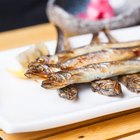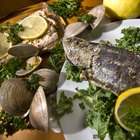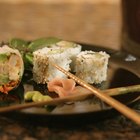
Some grocery store fish may be safe for sushi, but you must select sushi-grade fish and know what to look for to ensure your safety. There are many grades of fish, and those intended to be eaten raw are of a higher quality than those meant to be cooked. Knowing what to look for can help you select fish for sushi that will be both delicious and safe.
Sushi Basics
Sushi is a wide-ranging term that covers a variety of different items. Many types of sushi contain raw fish, while others feature fish that have been cooked or lightly cooked. Sushi can mean rolls of vegetables, fish and rice wrapped in seaweed or the more traditional nigiri sushi that is simply a pad of rice topped with raw fish. For any cooked sushi rolls, using grocery store fish is the simplest option. If you plan on eating fish raw, purchase sushi-grade fish, which can be found at high-end or specialty grocery stores. This higher-quality fish is often flash frozen to kill parasites and is specifically intended for raw consumption.
Sushi-Grade Fish Sources
Sushi grade fish is most commonly available at Japanese grocers or other Asian markets. If you do not have a Japanese supermarket in your area, shopping online is a good option to source high-quality sushi grade fish. Several retailers sell and ship a wide range of sushi-grade fish and other seafood, making it easy to find exactly what you want. Some high-end grocery stores also sell fresh fish that is suitable for sushi; inquire at individual fish sellers to determine the freshness of the fish they are selling.
Sushi-Grade Fish Considerations
Before purchasing fish for sushi, speak with the fishmonger at your local grocery store to determine the freshness of fish available and its suitability for eating raw. Fish for raw eating should not be dark or dull colored; instead, it should be bright. It should be firm and smooth and not slimy to the touch. Fish should not have a strong smell either, as this indicates it is old. If purchasing a whole fish, check the gills for small amount of blood or a red color, which indicates freshness. Ensure there is no slime, which can be a sign of spoilage. Fish eyes should be clear and bulging, not sunken or cloudy.
Raw Fish Safety
Eating raw fish carries risk. Handling it properly helps to minimize those risks, but if a fish is infected with parasites, they can infect your body as well. Finding a source for quality fresh or frozen fish intended to be eaten raw is the best way to protect yourself from parasites and food-borne illness. Eat all raw fish within two days of purchase to minimize your risk of infection. To further protect yourself, freeze fish for seven days at or below -4 degrees Fahrenheit to ensure any existing parasites die.
Related Articles

Yellow Tail Tuna and Omega 3

Can You Cook Sushi-Grade Salmon?

How Long Does Tilapia Last Refrigerated?

How to Cook Fried Catfish Without It ...

How to Tell if Shrimp Is Not Fresh

How to Cook Mackerel in an Oven

How to Cook Ahi Tuna on a Frying Pan

Can You Fry Frozen Tilapia?

Can You Eat Sockeye Salmon Raw?

How to Cook Shishamo Fish

Fish Cooking Temperature

Canned Salmon and Metal Toxins

How Long Can Tuna Stay Fresh?

How to Cook Frozen, Boneless & Skinless ...
How Long Can Halibut Be Kept Frozen?

Difference Between Tilapia Loin and ...

How to Pickle Fish

Foods Containing DMAE

How Long Does It Take for Salmon to ...

Can I Eat Sushi Twice a Week?
References
Resources
Writer Bio
Based in Portland, Ore., Maxine Wallace is a writer with more than 12 years of experience. With a bachelor's degree in journalism and experience working on marketing campaigns for large media agencies, she is well-versed in multiple industries including the Internet, cooking, gardening, health, fitness, travel and holistic living.
Photo Credits
George Doyle/Stockbyte/Getty Images